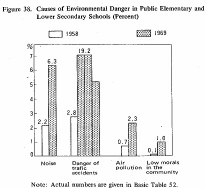| Home > Policy > White Paper, Notice, Announcement > White Paper > EDUCATIONAL STANDARDS IN JAPAN 1971 > CHAPTER |
||
According to a survey conducted by the Ministry of Education in 1969, 22.7%of the local public elementary schools and 24.7% of the public lower secondary schools consider their educational environment bad. Most of these schools raised" danger of traffic accidents on the way to school" as the main cause of this." noise", "air pollution", and "low moral standards in the community" also accounted for the bad environment, in that order. Comparing this with results of a survey conducted in 1958 all these defects have increased at a rapid pace. Notably, the citation of danger of traffic accidents on the way to school has increased sevenfold and from January to June of 1969, 54,000 pupils suffered from traffic accidents. Among them 9,000 cases were caused by accidents occurring when pupils were going to school in the morning or coming back home in the afternoon or during school activities such as excursions or observations outside of school. Schools near roads with heavy traffic or with factories, military bases or airports nearby are often victims of noise. In the worst cases sometimes classes have to be stopped for a while. As examples of sufferings caused by air pollution, the case in Yokkaichi City can be pointed out where, owing to sulphurous acid gas many residents got asthma. There is also the case of photochemical smog caused by the exhaust gas of automobiles. This has recently attracted people's attention in general and it has had a strong effect on pupils' health as well.
Schools are making efforts to protect themselves from these disasters by attempts to improve local traffic conditions, by the teaching of transportation safety, by constructing double windows or ventilation apparatus, by building sound proof rooms and by evacuation of classrooms for a certain period to places with clean air. Summer classes in resort areas are also encouraged, and health inspection is conducted more frequently to detect diseases as early as possible. 'Especially for the pupils of compulsory schools special care should be given to the environment of the school from the viewpoint of their age and stage of development. Urgent countermeasures should be taken with the colaboration of the government, prefectures, local governments, industrial circles and schools.
The worsening of the environment is a big problem throughout advanced nations where industry is highly developed. Consequently the problem of securing favorable school environments and education on environment is now often a subject of discussion in conferences of international education organizations. President Nixon of the United States presented a report on environment to the Congress in August. 1969 and stressed the importance of teaching pupils of elementary and secondary schools the importance of protecting the environment. There the President also pointed out that in universities, research departments on environmental problems should be established and efforts should be made to develop the technicians and engineers necessary for the solution of this problem.

Note: Actual numbers are given in Basic Table 52. Basic Table 52
| Back to Top | MEXT HOME |